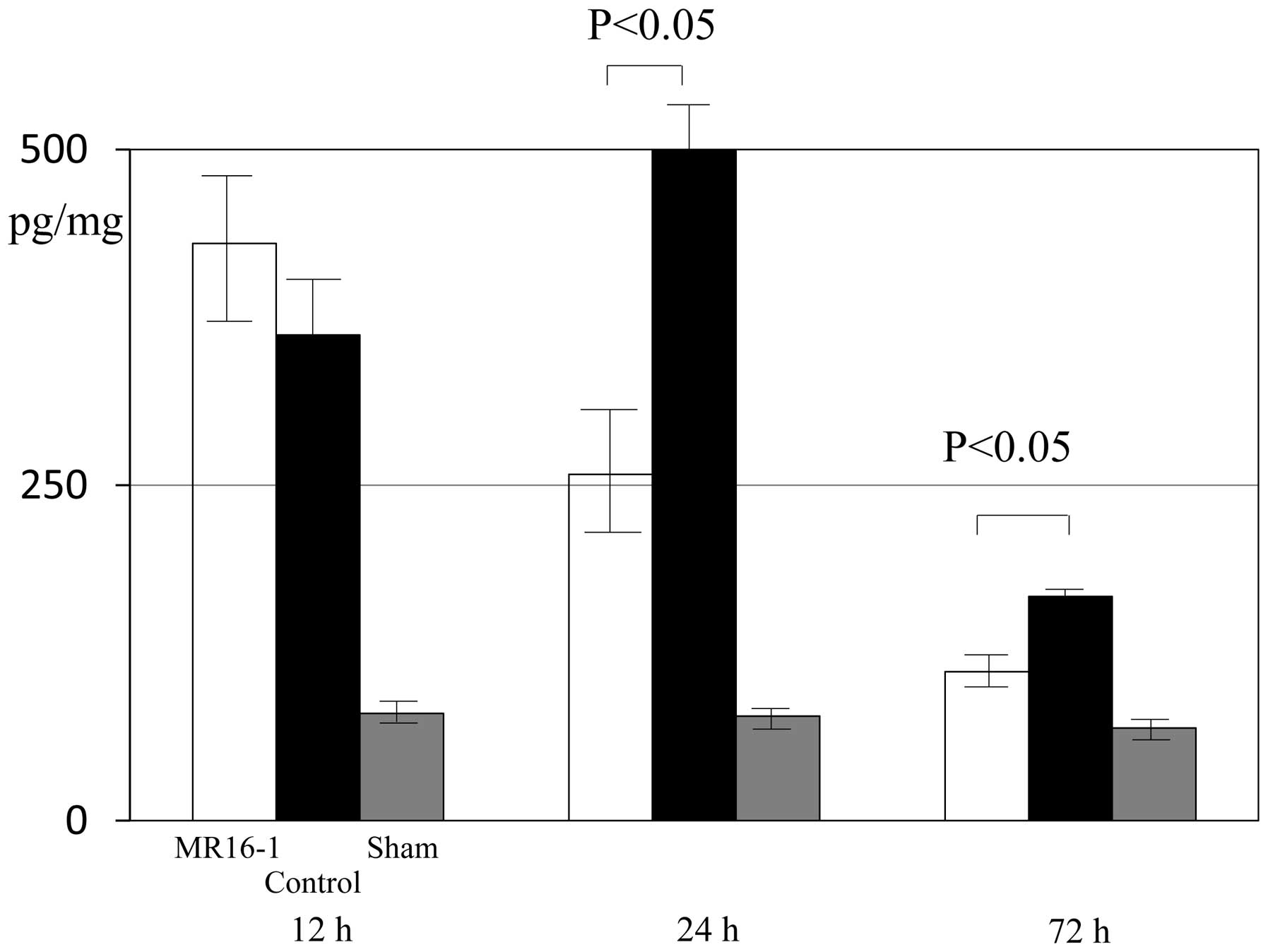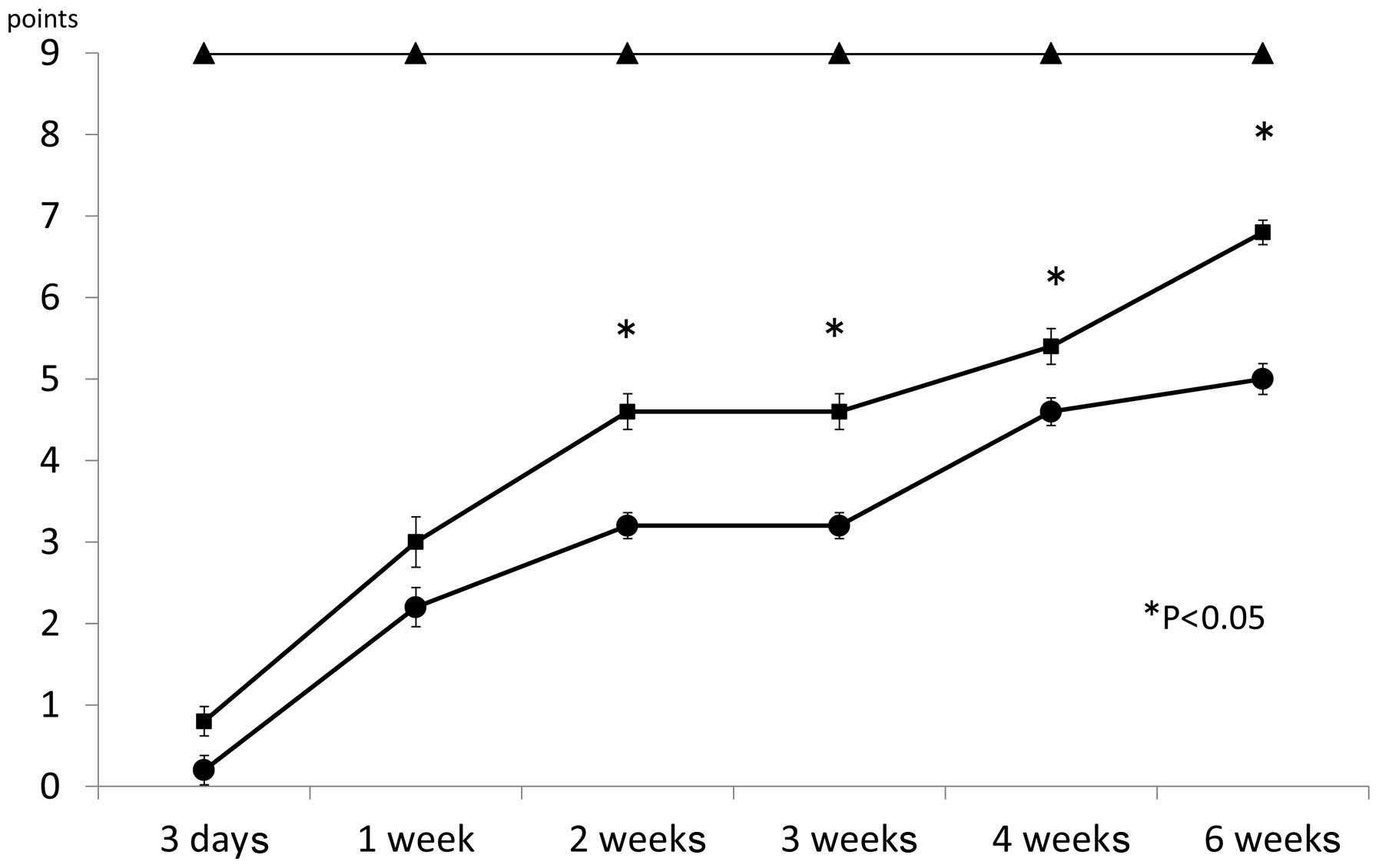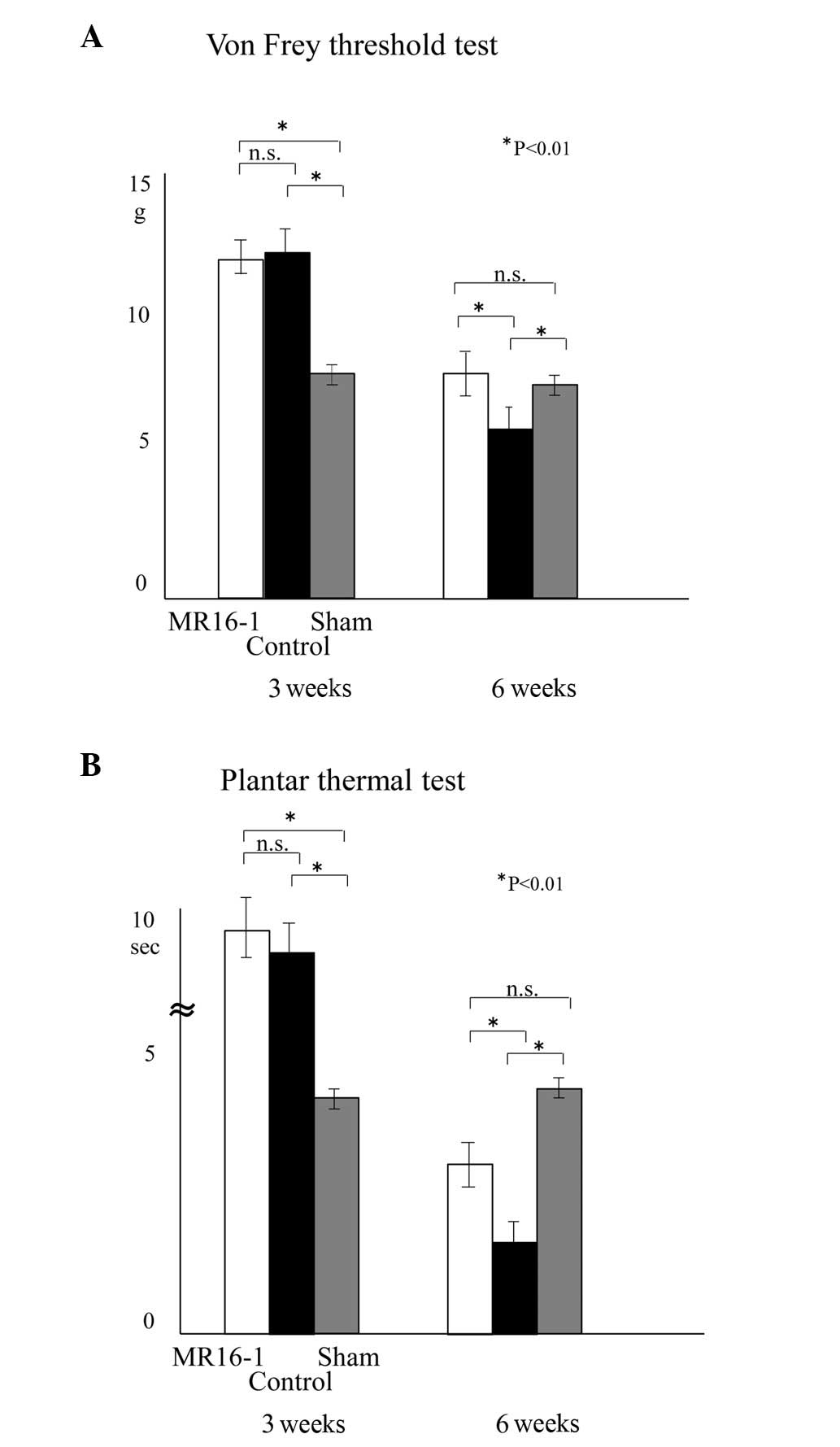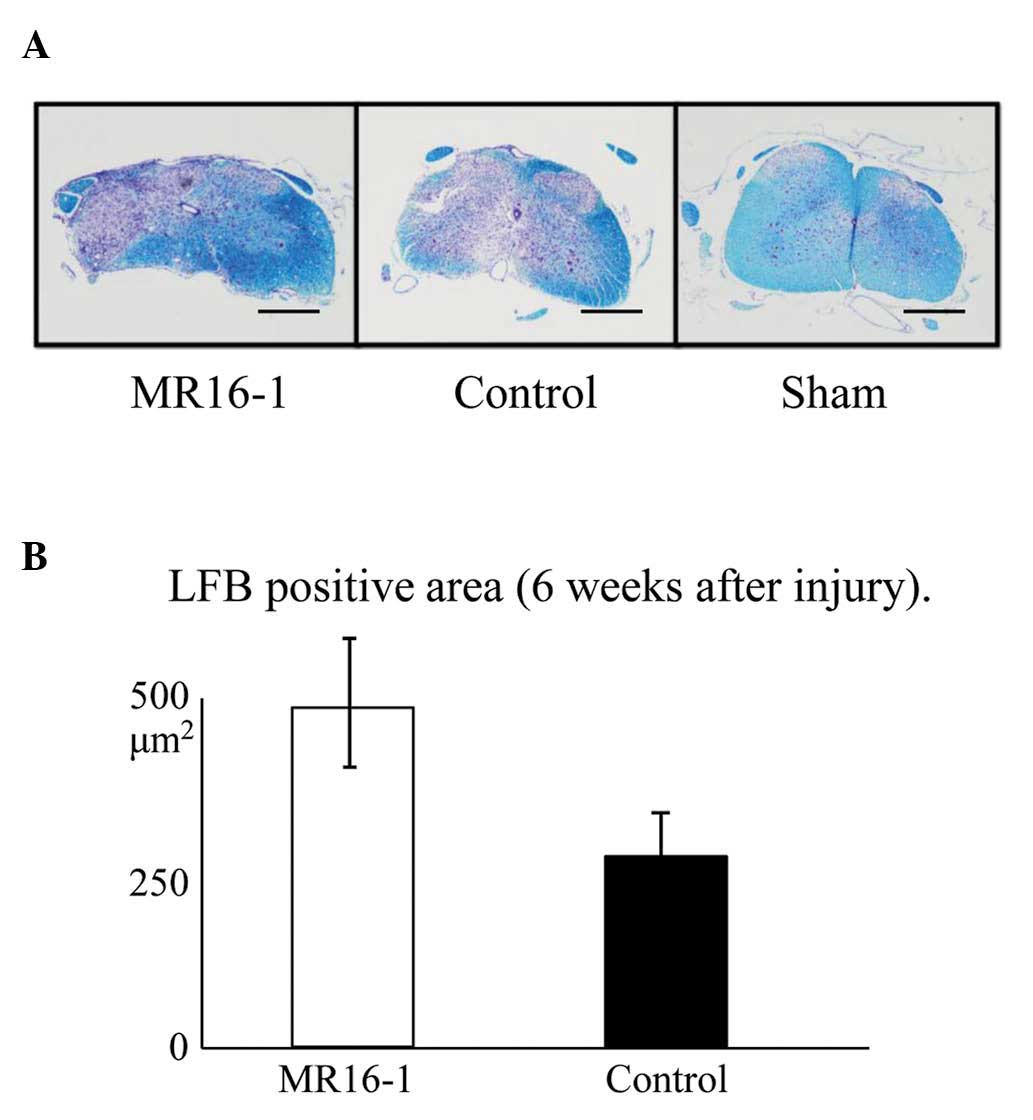|
1.
|
Donnelly DJ and Popovich PG: Inflammation
and its role in neuroprotection, axonal regeneration and functional
recovery after spinal cord injury. Exp Neurol. 209:378–388. 2008.
View Article : Google Scholar : PubMed/NCBI
|
|
2.
|
Jones TB, McDaniel EE and Popovich PG:
Inflammatory-mediated injury and repair in the traumatically
injured spinal cord. Curr Pharm Des. 11:1223–1236. 2005. View Article : Google Scholar : PubMed/NCBI
|
|
3.
|
Popovich PG and Jones TB: Manipulating
neuroinflammatory reactions in the injured spinal cord: back to
basics. Trends Pharmacol Sci. 24:13–17. 2003. View Article : Google Scholar : PubMed/NCBI
|
|
4.
|
Schwab JM, Brechtel K, Mueller CA, et al:
Experimental strategies to promote spinal cord regeneration - an
integrative perspective. Prog Neurobiol. 78:91–116. 2006.
View Article : Google Scholar : PubMed/NCBI
|
|
5.
|
Thuret S, Moon LD and Gage FH: Therapeutic
interventions after spinal cord injury. Nat Rev Neurosci.
7:628–643. 2006. View
Article : Google Scholar : PubMed/NCBI
|
|
6.
|
Lee HL, Lee KM, Son SJ, Hwang SH and Cho
HJ: Temporal expression of cytokines and their receptors mRNAs in a
neuropathic pain model. Neuroreport. 15:2807–2811. 2004.PubMed/NCBI
|
|
7.
|
Siddall P, Xu CL and Cousins M: Allodynia
following traumatic spinal cord injury in the rat. Neuroreport.
6:1241–1244. 1995. View Article : Google Scholar : PubMed/NCBI
|
|
8.
|
Okada S, Nakamura M, Mikami Y, et al:
Blockade of interleukin-6 receptor suppresses reactive astrogliosis
and ameliorates functional recovery in experimental spinal cord
injury. J Neurosci Res. 76:265–276. 2004. View Article : Google Scholar : PubMed/NCBI
|
|
9.
|
Mukaino M, Nakamura M, Yamada O, et al:
Anti-IL-6-receptor antibody promotes repair of spinal cord injury
by inducing microglia-dominant inflammation. Exp Neurol.
224:403–414. 2010. View Article : Google Scholar : PubMed/NCBI
|
|
10.
|
Lacroix S, Chang L, Rose-John S and
Tuszynski MH: Delivery of hyper-interleukin-6 to the injured spinal
cord increases neutrophil and macrophage infiltration and inhibits
axonal growth. J Comp Neurol. 454:213–228. 2002. View Article : Google Scholar : PubMed/NCBI
|
|
11.
|
Hirano T, Nakajima K and Hibi M: Signaling
mechanisms through gp130: a model of the cytokine system. Cytokine
Growth Factor Rev. 8:241–252. 1997. View Article : Google Scholar : PubMed/NCBI
|
|
12.
|
Cattaneo E, Conti L and De-Fraja C:
Signalling through the JAK-STAT pathway in the developing brain.
Trends Neurosci. 22:365–369. 1999. View Article : Google Scholar : PubMed/NCBI
|
|
13.
|
Dominguez E, Rivat C, Pommier B, Mauborgne
A and Pohl M: JAK/STAT3 pathway is activated in spinal cord
microglia after peripheral nerve injury and contributes to
neuropathic pain development in rat. J Neurochem. 107:50–60. 2008.
View Article : Google Scholar : PubMed/NCBI
|
|
14.
|
Yamauchi K, Osuka K, Takayasu M, et al:
Activation of JAK/STAT signalling in neurons following spinal cord
injury in mice. J Neurochem. 96:1060–1070. 2006. View Article : Google Scholar : PubMed/NCBI
|
|
15.
|
Dominguez E, Mauborgne A, Mallet J,
Desclaux M and Pohl M: SOCS3-mediated blockade of JAK/STAT3
signaling pathway reveals its major contribution to spinal cord
neuroinflammation and mechanical allodynia after peripheral nerve
injury. J Neurosci. 30:5754–5766. 2010. View Article : Google Scholar
|
|
16.
|
Okazaki M, Yamada Y, Nishimoto N,
Yoshizaki K and Mihara M: Characterization of anti-mouse
interleukin-6 receptor antibody. Immunol Lett. 84:231–240. 2002.
View Article : Google Scholar : PubMed/NCBI
|
|
17.
|
Scheff SW, Rabchevsky AG, Fugaccia I, Main
JA and Lumpp JE Jr: Experimental modeling of spinal cord injury:
characterization of a force-defined injury device. J Neurotrauma.
20:179–193. 2003. View Article : Google Scholar : PubMed/NCBI
|
|
18.
|
Nakajima Y, Osuka K, Seki Y, et al:
Taurine reduces inflammatory responses after spinal cord injury. J
Neurotrauma. 27:403–410. 2010. View Article : Google Scholar : PubMed/NCBI
|
|
19.
|
Basso DM, Fisher LC, Anderson AJ, Jakeman
LB, McTigue DM and Popovich PG: Basso Mouse Scale for locomotion
detects differences in recovery after spinal cord injury in five
common mouse strains. J Neurotrauma. 23:635–659. 2006. View Article : Google Scholar
|
|
20.
|
Hargreaves K, Dubner R, Brown F, Flores C
and Joris J: A new and sensitive method for measuring thermal
nociception in cutaneous hyperalgesia. Pain. 32:77–88. 1988.
View Article : Google Scholar : PubMed/NCBI
|
|
21.
|
Kim HY, Wang J, Lu Y, Chung JM and Chung
K: Superoxide signaling in pain is independent of nitric oxide
signaling. Neuroreport. 20:1424–1428. 2009. View Article : Google Scholar : PubMed/NCBI
|
|
22.
|
Chen KB, Uchida K, Nakajima H, et al:
Tumor necrosis factor-α antagonist reduces apoptosis of neurons and
oligodendroglia in rat spinal cord injury. Spine (Phila Pa 1976).
36:1350–1358. 2011.
|
|
23.
|
Cho N, Nguyen DH, Satkunendrarajah K,
Branch DR and Fehlings MG: Evaluating the role of IL-11, a novel
cytokine in the IL-6 family, in a mouse model of spinal cord
injury. J Neuroinflammation. 9:1342012. View Article : Google Scholar : PubMed/NCBI
|
|
24.
|
Klusman I and Schwab ME: Effects of
pro-inflammatory cytokines in experimental spinal cord injury.
Brain Res. 762:173–184. 1997. View Article : Google Scholar : PubMed/NCBI
|
|
25.
|
Guerrero AR, Uchida K, Nakajima H, et al:
Blockade of interleukin-6 signaling inhibits the classic pathway
and promotes an alternative pathway of macrophage activation after
spinal cord injury in mice. J Neuroinflammation. 9:402012.
View Article : Google Scholar : PubMed/NCBI
|
|
26.
|
Chandran AP, Oda K, Shibasaki H and
Pisharodi M: Spinal somatosensory evoked potentials in mice and
their developmental changes. Brain Dev. 16:44–51. 1994. View Article : Google Scholar : PubMed/NCBI
|













